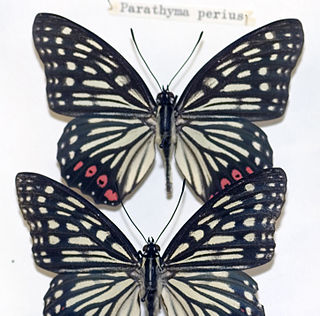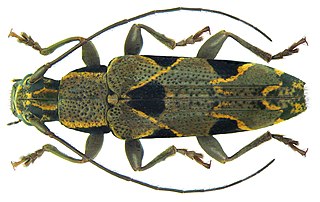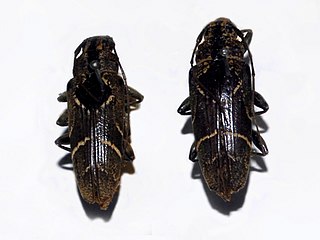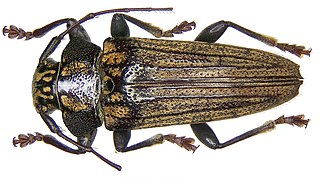
The allied rock-wallaby or Weasel rock-wallaby is a species of rock-wallaby found in northeastern Queensland, Australia. It forms part of the P. lateralis/penicillata species complex and is very similar to six other species of rock-wallaby found in this area; these include the Cape York rock-wallaby, the unadorned rock-wallaby, the Herbert's rock-wallaby, the Godman's rock-wallaby, the Mareeba rock-wallaby and the Mount Claro rock-wallaby.

Hestina assimilis, the red ring skirt, is a species of butterfly in the family Nymphalidae found in Asia. It is generally of large size. There are several subspecies: H. a. assimilis, H. a. formosana (Moore, H. a. shirakii, and H. a. f. nigrivena

The leaden antwren is a species of bird in the family Thamnophilidae. It is found in the Amazon Basin. Its natural habitat is subtropical or tropical moist lowland forest.

Zimmer's flatbill or the yellow-margined flatbill is a species of bird in the tyrant flycatcher family Tyrannidae. It is found in humid forest in southern Central America, and the Chocó and Amazon in South America.

The white-throated thrush is a species of bird in the family Turdidae. It is found in Mexico and Central America, ranging south to central Panama. Its natural habitats are subtropical or tropical dry forests, subtropical or tropical moist lowland forests, and subtropical or tropical moist montane forests. It is common in its range and an extremely rare vagrant into Texas and Arizona; 3 sightings have been recorded.

Dawkinsia assimilis is a species of ray-finned fish in the genus Dawkinsia. It is endemic to the southern Western Ghats. They are known as Mascara Barb.

The Sri Lanka bay owl is a species of bay owl in the family Tytonidae. It is endemic to the island of Sri Lanka and the Western Ghats in Kerala, South Western India. It was considered a subspecies of the Oriental bay owl but is now treated as a full species due to its distinctive call, plumage and disjunct distribution.
Copelatus assimilis is a species of diving beetle. It is part of the genus Copelatus of the subfamily Copelatinae in the family Dytiscidae. It was described by Maurice Auguste Régimbart in 1985.

Tmesisternini is a tribe of beetles in the subfamily Lamiinae containing the following genera:

Tmesisternus is a genus of longhorn beetles belonging to the family Cerambycidae, subfamily Lamiinae.

Gryllus assimilis, commonly known as the Jamaican field cricket and sometimes referred to as the silent cricket among other names, is one of many cricket species known as a field cricket. Its natural habitats are the West Indies and parts of the southern United States, Mexico, and South America, though as a result of widespread breeding programs to supply feeder insects to the pet industry since 2010, it has become available commercially throughout North America and Europe.
Estola assimilis is a species of beetle in the family Cerambycidae. It was described by Stephan von Breuning in 1940. It is known from Brazil.
The Mayan sea catfish, also known as the Mayan catfish or the Maya sea catfish, is a species of sea catfish in the family Ariidae. It was described by Albert Günther in 1864, originally under the genus Arius. It is found in tropical brackish and freshwater bodies in Belize, Costa Rica, Guatemala, Honduras, Mexico, Nicaragua, and Panama. It can reach a maximum total length of 35 cm (14 in), but more commonly reaches a TL of 25 cm (9.8 in).
Tmesisternus agriloides is a species of beetle in the family Cerambycidae. It was described by Francis Polkinghorne Pascoe in 1867.

Tmesisternus distinctus is a species of beetle in the family Cerambycidae. It was described by Jean Baptiste Boisduval in 1835.
Tmesisternus dubius is a species of beetle in the family Cerambycidae. It was described by Xavier Montrouzier in 1855.
Tmesisternus jaspideus is a species of beetle in the family Cerambycidae. It was described by Jean Baptiste Boisduval in 1835.
Tmesisternus schaumii is a species of beetle in the family Cerambycidae. It was described by Francis Polkinghorne Pascoe in 1867. It is known from Moluccas, Australia, and the Solomon Islands.

Tmesisternus venatus is a species of beetle in the family Cerambycidae. It was described by James Thomson in 1864.

The purple-backed fairywren is a fairywren that is native to Australia. Described by Alfred John North in 1901, it has four recognised subspecies. In a species that exhibits sexual dimorphism, the brightly coloured breeding male has chestnut shoulders and azure crown and ear coverts, while non-breeding males, females and juveniles have predominantly grey-brown plumage, although females of two subspecies have mainly blue-grey plumage. Distributed over much of the Australian continent, the purple-backed fairywren is found in scrubland with plenty of vegetation providing dense cover.











